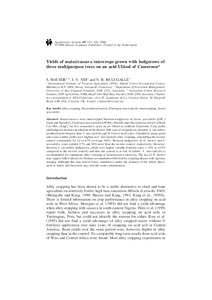| dc.contributor.author | Hauser, S. |
| dc.contributor.author | Ndi, J. |
| dc.contributor.author | Hulugalle, N. |
| dc.date.accessioned | 2019-12-04T11:21:06Z |
| dc.date.available | 2019-12-04T11:21:06Z |
| dc.date.issued | 2000 |
| dc.identifier.citation | Hauser, S., Ndi, J. & Hulugalle, N. (2000). Yields of maize/cassava intercrops grown with hedgerows of three multipurpose trees on an acid Ultisol of Cameroon. Agroforestry Systems, 49,111-122. |
| dc.identifier.issn | 0167-4366 |
| dc.identifier.uri | https://hdl.handle.net/20.500.12478/3668 |
| dc.description.abstract | Maize/cassava were intercropped between hedgerows of Senna spectabilis [(DC.) Irwin and Barneby], Flemingia macrophylla [(Willd.) Merrill] and Dactyladenia barteri [(Hook f ex Oliv.) Engl.] for five consecutive years on an Ultisol in southern Cameroon. Crop yields and hedgerow biomass production in the third to fifth year of cropping are reported. S. spectabilis produced more biomass than F. macrophylla and D. barteri in all years. Cumulative maize grain and cassava tuber yields were highest in F. macrophylla alley cropping, outyielding the no-tree control consistently by 42 to 67% (average 56%). Between hedgerows of D. barteri and S. spectabilis, crops yielded 17% and 16% more than the no-tree control, respectively. However, between S. spectabilis hedgerows, yields were highly variable between years (−15% to +35% compared to the no-tree control) and thus the system is at risk of failure. F. macrophylla is recommended for continuous alley cropping of maize/cassava intercrop. The use of D. barteri may require fallow phases for biomass accumulation followed by cropping phases with rigorous pruning. Although this may lead to lower cumulative yields, the products of the fallow phase, such as stakes and firewood, may provide some compensation. |
| dc.language.iso | en |
| dc.subject | Alley Cropping |
| dc.subject | Dactyladenia Barteri |
| dc.subject | Flemingia Macrophylla Intercropping |
| dc.subject | Senna Spectabilis |
| dc.subject | Biomass |
| dc.subject | Hedgerows |
| dc.subject | Intercropping |
| dc.title | Yields of maize/cassava intercrops grown with hedgerows of three multipurpose trees on an acid Ultisol of Cameroon |
| dc.type | Journal Article |
| dc.description.version | Peer Review |
| cg.contributor.affiliation | International Institute of Tropical Agriculture |
| cg.contributor.affiliation | University of New England |
| cg.contributor.affiliation | Australian Cotton Research Institute |
| cg.coverage.region | Africa |
| cg.coverage.region | Acp |
| cg.coverage.region | Central Africa |
| cg.coverage.region | Pacific |
| cg.coverage.country | Cameroon |
| cg.coverage.country | Australia |
| cg.isijournal | ISI Journal |
| cg.authorship.types | CGIAR and advanced research institute |
| cg.iitasubject | Plant Breeding |
| cg.iitasubject | Plant Production |
| cg.iitasubject | Plant Diseases |
| cg.iitasubject | Cassava |
| cg.iitasubject | Diseases Control |
| cg.iitasubject | Pests Of Plant |
| cg.iitasubject | Handling, Transport, Storage And Protection Of Agricultural Products |
| cg.iitasubject | Farm Management |
| cg.iitasubject | Capacity Development |
| cg.iitasubject | Livelihoods |
| cg.accessibilitystatus | Limited Access |
| local.dspaceid | 95823 |

